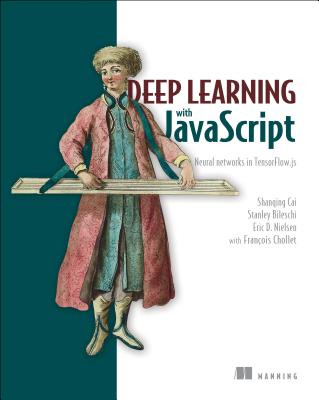Programmed Visions: Software and Memory (Hardcover)
暫譯: 程式化的視野:軟體與記憶 (精裝版)
Wendy Hui Kyong Chun
- 出版商: MIT
- 出版日期: 2011-04-29
- 售價: $1,225
- 貴賓價: 9.8 折 $1,201
- 語言: 英文
- 頁數: 256
- 裝訂: Hardcover
- ISBN: 0262015420
- ISBN-13: 9780262015424
-
相關分類:
大數據 Big-data、軟體工程、雲端運算
立即出貨 (庫存 < 3)
買這商品的人也買了...
-
 $2,280Working Effectively with Legacy Code (Paperback)
$2,280Working Effectively with Legacy Code (Paperback) -
 Expressive Processing: Digital Fictions, Computer Games, and Software Studies (Hardcover)
Expressive Processing: Digital Fictions, Computer Games, and Software Studies (Hardcover)$1,220$1,196 -
 Code/Space: Software and Everyday Life (Hardcover)
Code/Space: Software and Everyday Life (Hardcover)$1,980$1,881 -
 Spring in Action, 4/e (Paperback)
Spring in Action, 4/e (Paperback)$1,900$1,805 -
 Arduino 官方正版 Genuino 101
Arduino 官方正版 Genuino 101$1,700$1,700 -
 Raspberry Pi 3 Model B+ (UK製)
Raspberry Pi 3 Model B+ (UK製)$4,620$4,389 -
 JVM Performance Engineering: Inside OpenJDK and the HotSpot Java Virtual Machine (Paperback)
JVM Performance Engineering: Inside OpenJDK and the HotSpot Java Virtual Machine (Paperback)$1,980$1,881 -
 晉昇軟體最高殿堂:Jenkins2 持續整合大師之路
晉昇軟體最高殿堂:Jenkins2 持續整合大師之路$600$474 -
 $1,452Deep Learning with JavaScript: Neural Networks in Tensorflow.Js
$1,452Deep Learning with JavaScript: Neural Networks in Tensorflow.Js -
 JavaScript 技術手冊
JavaScript 技術手冊$560$442 -
 Building a Future-Proof Cloud Infrastructure: A Unified Architecture for Network, Security and Storage Services (Paperback)
Building a Future-Proof Cloud Infrastructure: A Unified Architecture for Network, Security and Storage Services (Paperback)$1,998$1,898 -
 $1,742Microservices Security in Action
$1,742Microservices Security in Action -
 Java SE 14 技術手冊
Java SE 14 技術手冊$680$537 -
 $2,156Parallel and High Performance Computing (Paperback)
$2,156Parallel and High Performance Computing (Paperback) -
 $1,840Multithreaded JavaScript: Concurrency Beyond the Event Loop
$1,840Multithreaded JavaScript: Concurrency Beyond the Event Loop -
 $2,420Software Architecture: The Hard Parts: Modern Trade-Off Analyses for Distributed Architectures (Paperback)
$2,420Software Architecture: The Hard Parts: Modern Trade-Off Analyses for Distributed Architectures (Paperback) -
 Structure and Interpretation of Computer Programs: JavaScript Edition (Paperback)
Structure and Interpretation of Computer Programs: JavaScript Edition (Paperback)$2,680$2,626 -
 $1,824Mastering API Architecture: Design, Operate, and Evolve Api-Based Systems (Paperback)
$1,824Mastering API Architecture: Design, Operate, and Evolve Api-Based Systems (Paperback) -
 OAuth 2.0 從入門到實戰:利用驗證和授權守護 API 的安全
OAuth 2.0 從入門到實戰:利用驗證和授權守護 API 的安全$600$510 -
 $2,233Functional and Concurrent Programming: Core Concepts and Features
$2,233Functional and Concurrent Programming: Core Concepts and Features -
 $1,805Functional Design: Principles, Patterns, and Practices (Paperback)
$1,805Functional Design: Principles, Patterns, and Practices (Paperback) -
 OpenTelemetry 入門指南:建立全面可觀測性架構(iThome鐵人賽系列書)【軟精裝】
OpenTelemetry 入門指南:建立全面可觀測性架構(iThome鐵人賽系列書)【軟精裝】$750$585 -
 $1,892Learning Systems Thinking: Essential Nonlinear Skills and Practices for Software Professionals (Paperback)
$1,892Learning Systems Thinking: Essential Nonlinear Skills and Practices for Software Professionals (Paperback) -
 $1,742Collaborative Software Design: How to Facilitate Domain Modeling Decisions
$1,742Collaborative Software Design: How to Facilitate Domain Modeling Decisions -
 $2,119Mastering Opentelemetry and Observability: Enhancing Application and Infrastructure Performance and Avoiding Outages
$2,119Mastering Opentelemetry and Observability: Enhancing Application and Infrastructure Performance and Avoiding Outages
商品描述
New media thrives on cycles of obsolescence and renewal: from celebrations of cyber-everything to Y2K, from the dot-com bust to the next big things--mobile mobs, Web 3.0, cloud computing. In Programmed Visions, Wendy Hui Kyong Chun argues that these cycles result in part from the ways in which new media encapsulates a logic of programmability. New media proliferates "programmed visions," which seek to shape and predict--even embody--a future based on past data. These programmed visions have also made computers, based on metaphor, metaphors for metaphor itself, for a general logic of substitutability. Chun approaches the concept of programmability through the surprising materialization of software as a "thing" in its own right, tracing the hardening of programming into software and of memory into storage. She argues that the clarity offered by software as metaphor should make us pause, because software also engenders a profound sense of ignorance: who knows what lurks behind our smiling interfaces, behind the objects we click and manipulate? The less we know, the more we are shown. This paradox, Chun argues, does not diminish new media's power, but rather grounds computing's appeal. Its combination of what can be seen and not seen, known (knowable) and not known--its separation of interface from algorithm and software from hardware--makes it a powerful metaphor for everything we believe is invisible yet generates visible, logical effects, from genetics to the invisible hand of the market, from ideology to culture.
商品描述(中文翻譯)
新媒體在過時與更新的循環中蓬勃發展:從對網路一切的慶祝到千年蟲(Y2K),從網路泡沫到下一個大事件——行動群體、Web 3.0、雲端運算。在《程式化的願景》中,Wendy Hui Kyong Chun 主張這些循環部分源於新媒體如何封裝可程式化的邏輯。新媒體繁衍出「程式化的願景」,這些願景試圖塑造和預測——甚至具體化——基於過去數據的未來。這些程式化的願景也使得電腦成為隱喻的隱喻,成為一種替代邏輯的普遍隱喻。Chun 通過軟體作為一種「事物」的驚人具現化來探討可程式化的概念,追溯程式設計如何硬化為軟體,以及記憶如何轉變為儲存。她主張,軟體作為隱喻所提供的清晰度應該讓我們停下來思考,因為軟體也產生了深刻的無知感:誰知道我們微笑的介面背後潛藏著什麼,在我們點擊和操作的物件背後又隱藏著什麼?我們知道的越少,所展示的越多。Chun 主張,這一悖論並不減少新媒體的力量,反而為計算的吸引力奠定了基礎。它所能見與不可見、已知(可知)與未知的結合——介面與演算法、軟體與硬體的分離——使其成為一個強大的隱喻,涵蓋了我們相信是看不見卻產生可見、邏輯效應的一切,從基因學到市場的看不見之手,從意識形態到文化。














